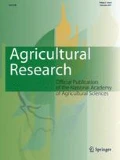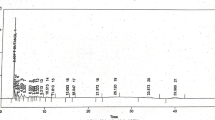Abstract
Black carrot (Daucus carota L. ssp. sativus var. atrorubens Alef.), an indigenous vegetable of India, has been widely used for the preparation of traditional fermented product Kanji, and traditional medicine for treating various kinds of diseases. Although previous research has reported its biochemical composition and some in vitro functional properties, very scanty information is available to date on the in vivo effect of black carrot. Given this gap of knowledge, this study was aimed to investigate the effect of black carrot on antioxidant defense, glucose metabolism and renal, as well as hepatic toxicity in normal Charles Foster albino rats. In addition, secondary metabolites were identified by high-resolution LCMS and in vitro antioxidant activity was also assessed. LC/MS/MS analysis revealed the presence of nine anthocyanins and two flavonols. Among these, four new compounds were putatively identified for the first time. Under in vivo condition, feeding of black carrot juice for 30 days resulted in the reduction in the superoxide dismutase activity, both in dose- and time-dependent manner. It was also observed that feeding of rats with black carrot juice for 30 days reduced their blood triglyceride concentration, both in dose- and time-dependent manners. No significant effect was observed on plasma glucose concentration, and also, no toxicity was noted with regard to the functioning of the kidney and liver.










Similar content being viewed by others
References
Aebi H (1984) [13] Catalase in vitro. Method Enzymol 105:121–126
Algarra M, Fernandes A, Mateus N, de Freitas V, da Silva JCE, Casado J (2014) Anthocyanin profile and antioxidant capacity of black carrots (Daucus carota L. ssp. sativus var. AtrorubensAlef.) from Cuevas Bajas, Spain. J Food Compos Anal 33:71–76
Balasubramaniam P, Malathi A (1992) Comparative study of haemoglobin estimated by Drabkin’s and Sahli’s methods. J Postgrad Med 38:8
Beauchamp C, Fridovich I (1971) Superoxide dismutase: improved assays and an assay applicable to acrylamide gels. Anal Biochem 44:276–287
Brand-Williams W, Cuvelier ME, Berset CLWT (1995) Use of a free radical method to evaluate antioxidant activity. LWT-Food Sci Technol 28:25–30
de Souza RF, Sussuchi EM, De Giovani WF (2003) Synthesis, electrochemical, spectral, and antioxidant properties of complexes of flavonoids with metal ions. Synth React Inorg Metal-Organic Chem 33:1125–1144
Gläßgen WE, Wray V, Strack D, Metzger JW, Seitz HU (1992) Anthocyanins from cell suspension cultures of Daucus carota. Phytochem 31:1593–1601
Guo H, Liu G, Zhong R, Wang Y, Wang D, Xia M (2012) Cyanidin-3-O-β-glucoside regulates fatty acid metabolism via an AMP-activated protein kinase-dependent signaling pathway in human HepG2 cells. Lipids Health Dis 11:10
Kamiloglu S, Pasli AA, Ozcelik B, Van Camp J, Capanoglu E (2015) Colour retention, anthocyanin stability and antioxidant capacity in black carrot (Daucus carota) jams and marmalades: effect of processing, storage conditions and in vitro gastrointestinal digestion. J Funct Food 13:1–10
Kammerer D, Carle R, Schieber A (2003) Detection of peonidin and pelargonidin glycosides in black carrots (Daucus carota ssp. sativus var. Atrorubens Alef.) by high-performance liquid chromatography/electrospray ionization mass spectrometry. Rapid Commun Mass Spectrom 17:2407–2412
Kammerer D, Carle R, Schieber A (2004) Characterization of phenolic acids in black carrots (Daucus carota ssp. sativus var. Atrorubens Alef.) by high performance liquid chromatography/electrospray ionization mass spectrometry. Rapid Commun Mass Spectrom 18:1331–1340
Kaur C, Kapoor HC (2002) Antioxidant activity and total phenolic content of some Asian vegetables. Int J Food Sci Technol 37:153–161
Khandare V, Walia S, Singh M, Kaur C (2011) Black carrot (Daucus carota ssp. sativus) juice: processing effects on antioxidant composition and color. Food Bioprod Process 89:482–486
Koley TK, Singh S, Khemariya P, Sarkar A, Kaur C, Chaurasia SNS, Naik PS (2014) Evaluation of bioactive properties of Indian carrot (Daucus carota L.): a chemometric approach. Food Res Int 60:76–85
Li H, Deng Z, Zhu H, Hu C, Liu R, Young JC, Tsao R (2012) Highly pigmented vegetables: anthocyanin compositions and their role in antioxidant activities. Food Res Int 46:250–259
Montilla EC, Arzaba MR, Hillebrand S, Winterhalter P (2011) Anthocyanin composition of black carrot (Daucus carota ssp. sativus var. Atrorubens Alef.) cultivars antonina, beta sweet, deep purple, and purple haze. J Agric Food Chem 59:3385–3390
Netzel M, Netzel G, Kammerer DR, Schieber A, Carle R, Simons L, Bitsch I, Bitsch R, Konczak I (2007) Cancer cell antiproliferation activity and metabolism of black carrot anthocyanins. Innov Food Sci Emerg Technol 8:365–372
Nijveldt RJ, Van Nood ELS, Van Hoorn DE, Boelens PG, Van Norren K, Van Leeuwen PA (2001) Flavonoids: a review of probable mechanisms of action and potential applications. Am J Clin Nutr 74:418–425
Özyürek M, Bektaşoğlu B, Güçlü K, Güngör N, Apak R (2010) A novel hydrogen peroxide scavenging assay of phenolics and flavonoids using cupric reducing antioxidant capacity (CUPRAC) methodology. J Food Compos Anal 23:689–698
Park S, Kang S, Jeong DY, Jeong SY, Park JJ, Yun HS (2015) Cyanidin and malvidin in aqueous extracts of black carrots fermented with Aspergillus oryzae prevent the impairment of energy, lipid and glucose metabolism in estrogen-deficient rats by AMPK activation. Gene Nutr 10:6
Rathee P, Chaudhary H, Rathee S, Rathee D, Kumar V, Kohli K (2009) Mechanism of action of flavonoids as anti-inflammatory agents: a review. Inflamm Allergy Drug Target 8:229–235
Re R, Pellegrini N, Proteggente Pannala A, Yang M, Rice-Evans C (1999) Antioxidant activity applying an improved ABTS radical cation decolorization assay. Free Radic Biol Med 26:1231–1237
Reddan JR, Giblin FJ, Sevilla M, Padgaonkar V, Dziedzic DC, Leverenz VR, Misra IC, Chang JS, Pena JT (2003) Propyl gallate is a superoxide dismutase mimic and protects cultured lens epithelial cells from H2O2 insult. Exp Eye Res 76:49–59
Ren W, Qiao Z, Wang H, Zhu L, Zhang L (2003) Flavonoids: promising anticancer agents. Med Res Rev 23:519–534
Rene A, Abasq ML, Hauchard D, Hapiot P (2010) How do phenolic compounds react toward superoxide ion? A simple electrochemical method for evaluating antioxidant capacity. Anal Chem 82:8703–8710
Sevimli-Gur C, Cetin B, Akay S, Gulce-Iz S, Yesil-Celiktas O (2013) Extracts from black carrot tissue culture as potent anticancer agents. Plant Food Hum Nutr 68:293–298
Sun T, Simon PW, Tanumihardjo SA (2009) Antioxidant phytochemicals and antioxidant capacity of biofortified carrots (Daucus carotaL.) of various colors. J Agric Food Chem 57:4142–4147
Takikawa M, Inoue S, Horio F, Tsuda T (2010) Dietary anthocyanin-rich bilberry extract ameliorates hyperglycemia and insulin sensitivity via activation of AMP-activated protein kinase in diabetic mice. J Nutr 140:527–533
Towler MC, Hardie DG (2007) AMP-activated protein kinase in metabolic control and insulin signaling. Circ Res 100:328–341
Turker N, Aksay S, Ekiz Hİ (2004) Effect of storage temperature on the stability of anthocyanins of a fermented black carrot (Daucus carota L.) beverage: shalgam. J Agric Food Chem 52:3807–3813
Acknowledgements
This work was supported by the network project on high-value compounds, Indian Council of Agricultural Research. The authors are thankful to Dr. Suparna Banerjee for providing the editorial assistance.
Author information
Authors and Affiliations
Corresponding author
Ethics declarations
Conflict of interest
The authors declare no conflict of interest.
Rights and permissions
About this article
Cite this article
Koley, T.K., Srivastava, S., Tripathi, Y.B. et al. High-Resolution LCMS Profiling of Phenolic Compounds of Indian Black Carrot and Evaluation of Its Effect on Antioxidant Defense and Glucose Metabolism in Animal Model. Agric Res 8, 481–489 (2019). https://doi.org/10.1007/s40003-018-0389-4
Received:
Accepted:
Published:
Issue Date:
DOI: https://doi.org/10.1007/s40003-018-0389-4




